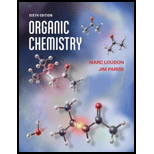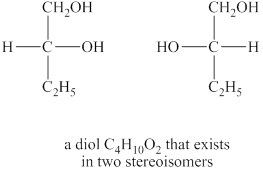
Concept explainers
(a)
Interpretation:
The structure of chiral ether
Concept introduction:
A carbon atom that has four non-equivalent atoms or groups attached to it is known as chiral carbon atom. Chiral carbon centers are also called as asymmetric or stereogenic centers.
The ethers contain
Answer to Problem 8.30AP
The structure of chiral ether

Explanation of Solution
The given molecular formula of ether is

Figure 1
The structure of chiral ether
(b)
Interpretation:
The structure of chiral alcohol with molecular formula
Concept introduction:
A carbon atom that has four non-equivalent atoms or groups attached to it is known as chiral carbon atom. Chiral carbon centers are also called as asymmetric or stereogenic centers.
The alcohols contain hydroxyl
Answer to Problem 8.30AP
The structure of chiral alcohol with molecular formula

Explanation of Solution
The given molecular formula of alcohol is

Figure 2
The structure of chiral alcohol with molecular formula
(c)
Interpretation:
The structure of vicinal glycol
Concept introduction:
The alcohols contain hydroxyl
Answer to Problem 8.30AP
The structure of vicinal glycol

Explanation of Solution
The given molecular formula of vicinal glycol is

Figure 3
The structure of vicinal glycol
(d)
Interpretation:
The structure of diol
Concept introduction:
The alcohols contain hydroxyl
Answer to Problem 8.30AP
The structures of diol

Explanation of Solution
The given molecular formula of diol is

Figure 4
The structures of diol
(e)
Interpretation:
The structure of diol
Concept introduction:
The alcohols contain hydroxyl
Answer to Problem 8.30AP
The structures of diol

Explanation of Solution
The given molecular formula of diol is

Figure 5
The structures of diol
(f)
Interpretation:
The structures of six
Concept introduction:
The ethers contain
Cyclic ethers with three-membered ring are commonly known as epoxide in which two carbons and one oxygen atom are arranged in cyclic form.
Answer to Problem 8.30AP
The structures of six epoxides (counting stereoisomers) with the molecular formula

Explanation of Solution
The given molecular formula of the epoxide is

Figure 6
The structures of six epoxides (counting stereoisomers) with the molecular formula
Want to see more full solutions like this?
Chapter 8 Solutions
Organic Chemistry
- this is an organic chemistry question please answer accordindly!! please post the solution draw the figures and post, answer the question in a very simple and straight forward manner thanks!!!!! please answer EACH part till the end and dont just provide wordy explanations wherever asked for structures or diagrams, please draw them on a paper and post clearly!! answer the full question with all details EACH PART CLEARLY please thanks!! im reposting this kindly solve all parts and draw it not just word explanations!!arrow_forwardPlease correct answer and don't used hand raitingarrow_forwardCurved arrows are used to illustrate the flow of electrons. Using the provided starting and product structures, draw the curved electron-pushing arrows for the following reaction or mechanistic step(s). Be sure to account for all bond-breaking and bond-making steps. Select to Edit Arrows H H Select to Add Arrows > H CFCI: Select to Edit Arrows H Select to Edit Arrowsarrow_forward
 ChemistryChemistryISBN:9781305957404Author:Steven S. Zumdahl, Susan A. Zumdahl, Donald J. DeCostePublisher:Cengage Learning
ChemistryChemistryISBN:9781305957404Author:Steven S. Zumdahl, Susan A. Zumdahl, Donald J. DeCostePublisher:Cengage Learning ChemistryChemistryISBN:9781259911156Author:Raymond Chang Dr., Jason Overby ProfessorPublisher:McGraw-Hill Education
ChemistryChemistryISBN:9781259911156Author:Raymond Chang Dr., Jason Overby ProfessorPublisher:McGraw-Hill Education Principles of Instrumental AnalysisChemistryISBN:9781305577213Author:Douglas A. Skoog, F. James Holler, Stanley R. CrouchPublisher:Cengage Learning
Principles of Instrumental AnalysisChemistryISBN:9781305577213Author:Douglas A. Skoog, F. James Holler, Stanley R. CrouchPublisher:Cengage Learning Organic ChemistryChemistryISBN:9780078021558Author:Janice Gorzynski Smith Dr.Publisher:McGraw-Hill Education
Organic ChemistryChemistryISBN:9780078021558Author:Janice Gorzynski Smith Dr.Publisher:McGraw-Hill Education Chemistry: Principles and ReactionsChemistryISBN:9781305079373Author:William L. Masterton, Cecile N. HurleyPublisher:Cengage Learning
Chemistry: Principles and ReactionsChemistryISBN:9781305079373Author:William L. Masterton, Cecile N. HurleyPublisher:Cengage Learning Elementary Principles of Chemical Processes, Bind...ChemistryISBN:9781118431221Author:Richard M. Felder, Ronald W. Rousseau, Lisa G. BullardPublisher:WILEY
Elementary Principles of Chemical Processes, Bind...ChemistryISBN:9781118431221Author:Richard M. Felder, Ronald W. Rousseau, Lisa G. BullardPublisher:WILEY





